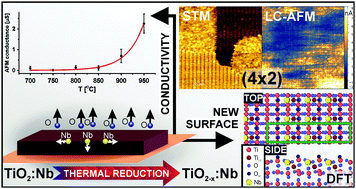当前位置:
X-MOL 学术
›
Phys. Chem. Chem. Phys.
›
论文详情
Our official English website, www.x-mol.net, welcomes your
feedback! (Note: you will need to create a separate account there.)
Tuning the surface structure and conductivity of niobium-doped rutile TiO2 single crystals via thermal reduction
Physical Chemistry Chemical Physics ( IF 2.9 ) Pub Date : 2017-09-05 00:00:00 , DOI: 10.1039/c7cp03136j D. Wrana 1, 2, 3, 4 , C. Rodenbücher 5, 6, 7, 8 , M. Krawiec 4, 9, 10, 11 , B. R. Jany 1, 2, 3, 4 , J. Rysz 1, 2, 3, 4 , M. Ermrich 8, 12, 13 , K. Szot 5, 6, 7, 8, 14 , F. Krok 1, 2, 3, 4
Physical Chemistry Chemical Physics ( IF 2.9 ) Pub Date : 2017-09-05 00:00:00 , DOI: 10.1039/c7cp03136j D. Wrana 1, 2, 3, 4 , C. Rodenbücher 5, 6, 7, 8 , M. Krawiec 4, 9, 10, 11 , B. R. Jany 1, 2, 3, 4 , J. Rysz 1, 2, 3, 4 , M. Ermrich 8, 12, 13 , K. Szot 5, 6, 7, 8, 14 , F. Krok 1, 2, 3, 4
Affiliation

|
We report on the systematic exploration of electronic and structural changes of Nb-doped rutile TiO2(110) single crystal surfaces due to the thermoreduction under ultra-high vacuum conditions (without sputtering), with comparison to undoped TiO2(110) crystals. It has been found that the surface of the doped sample undergoes a previously unknown transition during reduction above 850 °C, as provided by LEED, STM and LC-AFM. This transition involves a change from heterogeneous conductivity (due to the presence of conducting filaments) to homogeneous conductivity, connected with a new (4 × 2) reconstruction of rows parallel to the [001] direction. DFT calculations suggest substitution of Ti by Nb atoms in the first atomic layer. Due to the strong reducing conditions during annealing, oxygen is released from the crystal and Nb diffuses from the subsurface into the bulk, agglomerating however on the surface, as shown by SIMS depth profiling. We present that 0.5% Nb doping significantly influences the reduction process and in turn the structural properties of the surface by supporting the evolution of the new reconstruction. It is shown that the thermal treatment of TiO2:Nb under low oxygen partial pressure gives an opportunity to tune the electrical conductivity and work function of the surface.
中文翻译:

通过热还原调节铌掺杂金红石型TiO 2单晶的表面结构和电导率
我们报告了与未掺杂的TiO 2相比,由于在超高真空条件下(没有溅射)的热还原而导致的掺Nb的金红石型TiO 2(110)单晶表面的电子和结构变化的系统探索。(110)晶体。已经发现,如LEED,STM和LC-AFM提供的那样,掺杂样品的表面在850°C以上的还原过程中经历了以前未知的转变。这种转变涉及从异质电导率(由于存在导电细丝)到均质电导率的变化,并与平行于[001]方向的行进行了新的(4×2)重建。DFT计算表明在第一原子层中Ti被Nb原子取代。由于退火过程中强烈的还原条件,氧气从晶体中释放出来,Nb从次表面扩散到块体中,但是在表面上聚集,如SIMS深度剖析所示。我们提出那个0。5%的Nb掺杂会显着影响还原过程,进而通过支持新构造的发展反过来影响表面的结构特性。结果表明,TiO的热处理2:Nb在低氧分压下可以调节表面的电导率和功函。
更新日期:2017-09-22
中文翻译:

通过热还原调节铌掺杂金红石型TiO 2单晶的表面结构和电导率
我们报告了与未掺杂的TiO 2相比,由于在超高真空条件下(没有溅射)的热还原而导致的掺Nb的金红石型TiO 2(110)单晶表面的电子和结构变化的系统探索。(110)晶体。已经发现,如LEED,STM和LC-AFM提供的那样,掺杂样品的表面在850°C以上的还原过程中经历了以前未知的转变。这种转变涉及从异质电导率(由于存在导电细丝)到均质电导率的变化,并与平行于[001]方向的行进行了新的(4×2)重建。DFT计算表明在第一原子层中Ti被Nb原子取代。由于退火过程中强烈的还原条件,氧气从晶体中释放出来,Nb从次表面扩散到块体中,但是在表面上聚集,如SIMS深度剖析所示。我们提出那个0。5%的Nb掺杂会显着影响还原过程,进而通过支持新构造的发展反过来影响表面的结构特性。结果表明,TiO的热处理2:Nb在低氧分压下可以调节表面的电导率和功函。











































 京公网安备 11010802027423号
京公网安备 11010802027423号